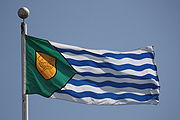
Flag of Vancouver
Encyclopedia

Vancouver
Vancouver is a coastal seaport city on the mainland of British Columbia, Canada. It is the hub of Greater Vancouver, which, with over 2.3 million residents, is the third most populous metropolitan area in the country,...
, British Columbia
British Columbia
British Columbia is the westernmost of Canada's provinces and is known for its natural beauty, as reflected in its Latin motto, Splendor sine occasu . Its name was chosen by Queen Victoria in 1858...
, Canada
Canada
Canada is a North American country consisting of ten provinces and three territories. Located in the northern part of the continent, it extends from the Atlantic Ocean in the east to the Pacific Ocean in the west, and northward into the Arctic Ocean...
, was adopted by City Council on May 17, 1983. It was designed by Robert Watt
Robert Watt
Robert Douglas Watt, LVO, FRHSC was the first Chief Herald of Canada. He was appointed at the foundation of the Canadian Heraldic Authority, and was succeeded by Claire Boudreau in 2007....
, then the Director of the Vancouver Museum
Vancouver Museum
The Museum of Vancouver is a local museum located in Vanier Park, Vancouver, British Columbia. The MOV is the largest civic museum in Canada. The museum was founded in 1894 and recently went through a major re-visioning process in 2008. It shares facilities with the H. R...
, and later the Chief Herald of Canada
Chief Herald of Canada
Chief Herald of Canada is the title held by the head of the Canadian Heraldic Authority. The Chief Herald of Canada directs the operations of the Canadian Heraldic Authority and makes the grants of arms. There are exceptions to this, such as certain grants made directly by the Governor General. The...
.
The chevron is green and surmounted by a gold shield with the city badge.
The city badge consists of a mural crown
Mural crown
-Usage in ancient times:In Hellenistic culture, a mural crown identified the goddess Tyche, the embodiment of the fortune of a city, familiar to Romans as Fortuna...
with crossed axe and paddle.
The mural crown states Vancouver's status as an incorporated city
City
A city is a relatively large and permanent settlement. Although there is no agreement on how a city is distinguished from a town within general English language meanings, many cities have a particular administrative, legal, or historical status based on local law.For example, in the U.S...
. The axe and paddle resemble the supporters
Supporters
In heraldry, supporters are figures usually placed on either side of the shield and depicted holding it up. These figures may be real or imaginary animals, human figures, and in rare cases plants or inanimate objects...
found on the Coat of Arms
Coat of arms of Vancouver
The coat of arms of Vancouver was granted by the College of Arms on 31 March 1969.-History:Over the course of its history, the city of Vancouver has used three distinct coats of arms. The first, designed by City Alderman Lauchlan Hamilton and assumed in 1886, was pictorial in nature depicting a...
and stand for the traditional industries, logging
Logging
Logging is the cutting, skidding, on-site processing, and loading of trees or logs onto trucks.In forestry, the term logging is sometimes used in a narrow sense concerning the logistics of moving wood from the stump to somewhere outside the forest, usually a sawmill or a lumber yard...
and fishing
Fishing
Fishing is the activity of trying to catch wild fish. Fish are normally caught in the wild. Techniques for catching fish include hand gathering, spearing, netting, angling and trapping....
. The green background is a symbol of the forests that used to stand on the city's location.
The wavy ribbons of white and azure symbolize the Pacific Ocean
Pacific Ocean
The Pacific Ocean is the largest of the Earth's oceanic divisions. It extends from the Arctic in the north to the Southern Ocean in the south, bounded by Asia and Australia in the west, and the Americas in the east.At 165.2 million square kilometres in area, this largest division of the World...
and rivers surrounding the city. They are similar to and bear the same meaning as on the flag of British Columbia
Flag of British Columbia
The flag of British Columbia is based upon the shield of the provincial arms of British Columbia. At the top of the flag is a rendition of the Union Flag, defaced in the centre by a crown, representing the province's origins as a British colony, with a setting sun below.-History:The British...
.

